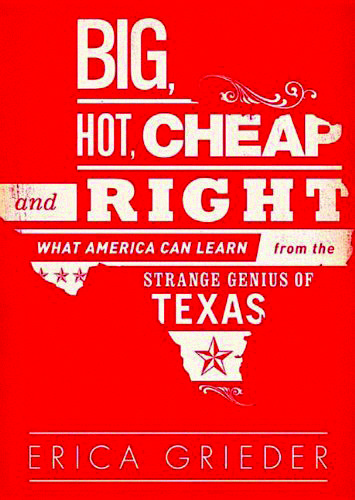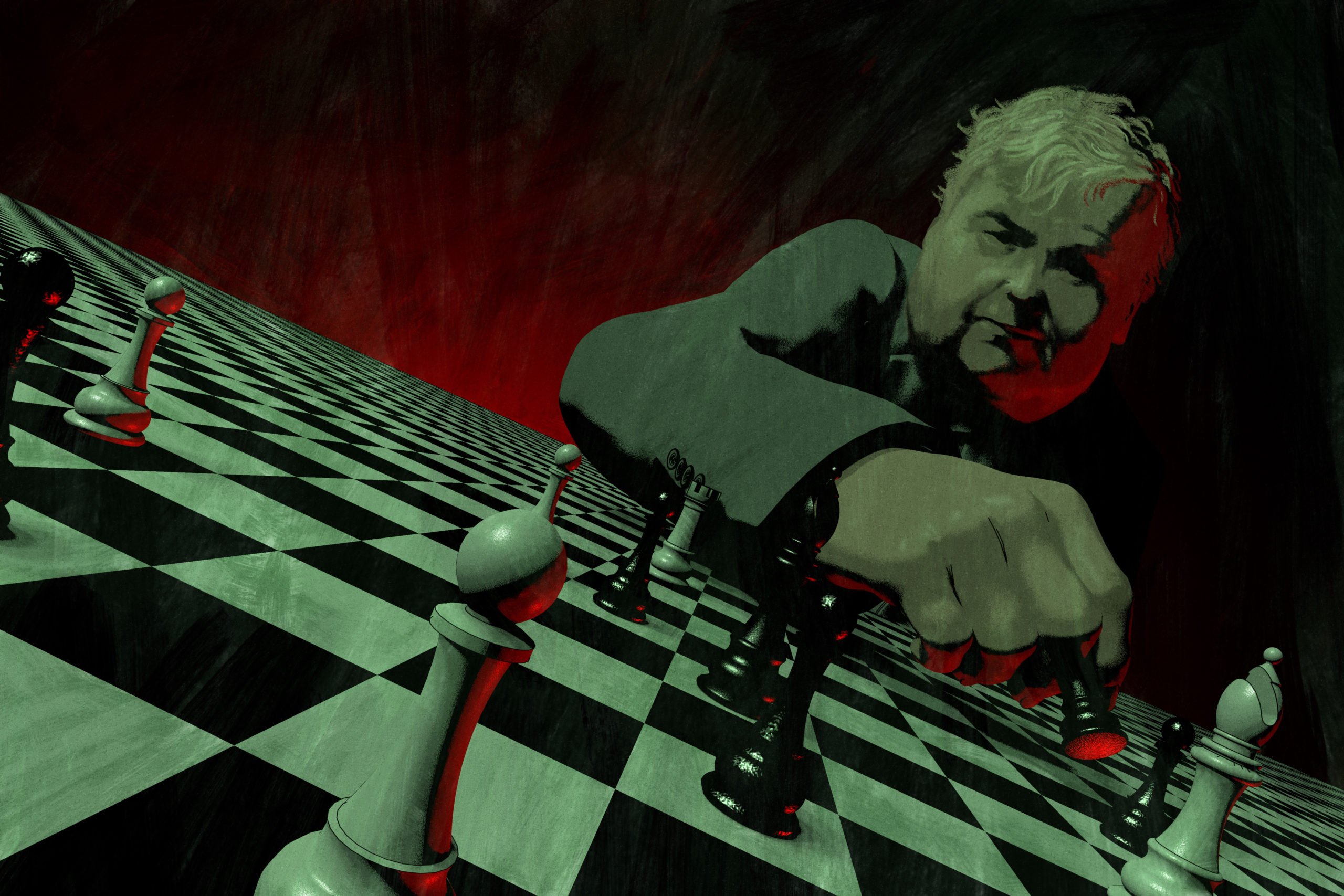
Erica Grieder Praises the “Texas Miracle” in Big, Hot, Cheap, And Right

A version of this story ran in the April 2013 issue.
Before his call to lynch the Federal Reserve chairman, before his widely panned homophobic non sequitur of a TV ad, before his infamous “oops,” presidential candidate Rick Perry had one big selling point: the supposed “Texas miracle” economy. Look to Texas, Perry said, for an off-the-shelf model of how to create jobs and shrink government. Texas, not California, would be the nation’s new beacon, and Gov. Perry was happy to take credit.
Perry’s braggadocio briefly set off a firestorm, drawing a welter of well-known pundits and economists into the debate. Paul Krugman called the Texas miracle “a myth.”
Perry’s humiliating campaign performance quickly ended his bully pulpit, but the question of whether Texas—which continues to grow in political and economic stature—is a model for emulation or mockery remains. Erica Grieder’s Big, Hot, Cheap and Right: What America Can Learn from the Strange Genius of Texas adds a welcome voice to the debate.
Grieder, a San Antonio native who recently moved from The Economist to Texas Monthly, is an astute observer of this state’s contradictions, and she avoids the caricature and cliché that plague so many books about Texas by non-Texans. Her forays into Texas history to explain the state’s myriad oddities are useful. Her target audience seems to be Left Coasters and Yankees who think of Texas in the same way a bar-back in Lubbock might view Bhutan. I hope they read the book.
But in seeking to knock down hoary stereotypes, Big, Hot risks becoming an apologia for the “Texas model,” which Grieder defines as low taxes, light on regulation and, above all, business-friendly. Sound familiar? It’s Rick Perry’s mantra. The book, despite its ample footnotes and judicious tone, not only defends but praises the status quo. In a chapter suggesting “tweaks” to the Texas model, Grieder comes up with just two suggestions to improve the state: raise the minimum wage (she doesn’t say how much), and “invest” in education.
“The Texas Model has clearly and incontrovertibly worked,” Grieder writes, and “The state is getting better for everyone. It’s strange that other Americans can’t seem to see that.” Political “excesses” can be justified by the economy alone—“one area where no one’s been disappointed.”
I’m not an economist, but a state in which a quarter of all people go without health insurance does not strike me as one possessing a system that “clearly and incontrovertibly worked.” A state where one out of four children live in poverty is not one that’s “getting better for everyone.” A state that’s second-to-last in per-capita spending on mental health care and has one of the highest incarceration rates in the world is not one “where no one’s been disappointed.”
Let’s look at the core of Grieder’s (and Perry’s) case: jobs, jobs, jobs.
Texas has generated a lot of jobs. Grieder, like Perry, points to a Federal Reserve Bank of Dallas finding that Texas accounted for 29.2 percent of net new jobs among states that had positive job growth between June 2009 and June 2011. As of December 2012, the Texas unemployment rate was 6.2 percent, right between New Hampshire and Idaho and 1.6 percent lower than the national average. A significant number of those jobs pay minimum wage or less. Texas has a higher percentage of workers earning minimum wage or less—7.5 percent in 2012—than any state except Idaho.
Still, Texas is doing better than most of the nation in job growth. Why?
First, population growth is explosive. Second, the booming oil and gas industry helps buoy the state economy, though not as much as it used to. Third, housing is cheap and abundant. Fourth (and this is totally subjective): It’s Texas, a fun, dynamic, interesting place to live! Even accounting for all that, the Texas economy continues to produce impressive job growth. Like Grieder, I think that phenomenon can be credited in part to the Texas model.
It’s plausible that by doing everything you possibly can to make life easy for big business—taxpayer-supported incentive packages, zero corporate and income tax, a captive regulatory system, weak labor unions, a political system up for sale to the highest bidder—that one state can out-compete others.
But a national economic policy this is not. It’s also not a sustainable model for long-term success. Reckless growth is not a perpetual-motion machine. Sooner or later, Texas’ lack of investment in infrastructure and education, wanton disregard for climate change, staggering income inequality and regressive tax structures will put sugar in the tank of the job-creation machine.
And in making the case for the Texas model, Grieder takes liberties with how the state is actually governed. She relies far too much on libertarian notions of government and human nature, and tries to jam Texas into that mold, even when it doesn’t fit. She argues, for example, that despite liberal caricatures, Perry hasn’t really pushed a conservative Christian social agenda (“because he’s lazy”).
Grieder points to the Legislature’s passage of a law requiring women to get a sonogram before terminating a pregnancy as an example of how other evangelical Republicans have been more activist. But she fails to mention that Perry made the sonogram law one of three emergency items for the 2011 session, virtually guaranteeing that it would, at a minimum, receive serious consideration. Perry’s fingerprints are all over the transvaginal probes now employed in service of the state’s pro-life movement.
Any serious book on the Texas model must also deal with the state’s anemic democratic engagement. Texas has one of the lowest voter-turnout rates in the nation. Grieder posits that this is because “Texans have been happy enough with the status quo. The government might not do much, but at the same time it doesn’t meddle with people that much, nor does it ask for much in terms of taxes.”
This is lazy political science, but it’s a view one often hears among the thousand or so people who constitute the politics-media-lobby elite in Austin. Texans who don’t vote are largely poor and minority, groups that vote less frequently than their counterparts in other large states, and at much lower rates than affluent whites, who still by and large run Texas. If poor minority Texans decline to vote as a means of expressing satisfaction with the system, then do rich white people vote to express dissatisfaction?
The former group tends not to vote for many reasons: lack of engagement with the political system, weak labor unions, a hobbled Democratic Party, poverty, barriers to voting, etc. There is no shortage of reasons; none of them argues for a healthy, wise electorate.
Grieder thinks Texans are happy with the Texas model. One of her reasons is that “[T]he people have been able to look elsewhere for the services the government can’t provide or won’t provide or both. Lobbyists, for example, are happy to take on some of the legislative opportunities and responsibilities that in a normal state would be handled by legislators.”
Well of course the lobbyists are happy to run things. But is this any way to conduct the people’s affairs? Do citizens—conservative, liberal or otherwise—really want government-by-lobbyist? How many medical bills do lobbyists cover for the uninsured?
Big, Hot also stumbles on some factual matters. “The schools are improving,” Grieder writes in the introduction. Later she writes: “Spending per pupil has dropped, then, because the number of kids is growing, and given that education already chews up a disproportionate part of the state budget, Texas politicians would be hard-pressed to spend more money on schools.”
Per-pupil spending has dropped not because the number of kids is growing—enrollment has been increasing steadily for decades—but because the GOP-controlled Texas Legislature slashed $5.4 billion out of public education in 2011. That was a choice, and it resulted in the state’s first-ever drop in per-student spending. Now, in 2013, the state is sitting on an $8.8 billion surplus and a $12 billion Rainy Day Fund. Lawmakers can decide to undo the cuts. Nothing is stopping them but a hard-right political ideology.
Finally, Big, Hot contains a curious omission. If, as Grieder writes, the “[Texas] model mostly predates Perry,” and if she thinks America should learn from Texas’ “strange genius,” then why does her book fail to mention a certain Texan president of the not-too-distant past? Didn’t George W. Bush spend eight years making the Texas model a national reality? That’s one chapter most Americans would be glad to keep closed.


